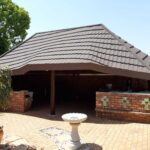Roof tiles are indeed designed to prevent water from seeping into the structure of a building. They serve as a protective layer over the roof, helping to shed water away from the underlying materials.
Roof tiles are typically made from materials like clay, concrete, or slate, which are naturally resistant to water. When properly installed with the appropriate overlap and underlayment, roof tiles create a barrier that repels water, preventing it from infiltrating into the interior of the building.
However, it’s essential to note that the effectiveness of roof tiles in preventing water ingress depends on various factors, including the quality of the tiles, the installation method, and the condition of the roof over time. Proper maintenance and periodic inspections are necessary to ensure that roof tiles continue to provide reliable water protection.
oof tiles offer several benefits:
- Water Resistance: As mentioned, roof tiles are designed to prevent water from seeping into the building. They create a barrier that sheds water away, protecting the underlying structure from moisture damage.
- Durability: Roof tiles are known for their durability and longevity. Materials like clay, concrete, and slate are inherently robust and can withstand various weather conditions, including heavy rain, wind, hail, and even fire in some cases. Properly maintained roof tiles can last for several decades.
- Aesthetic Appeal: Roof tiles come in a variety of colors, shapes, and styles, allowing homeowners to choose options that complement the architectural style of their homes. They add aesthetic value to the property and enhance its curb appeal.
- Energy Efficiency: Some types of roof tiles, such as clay tiles, have natural insulating properties. They can help regulate the temperature inside the building, reducing the need for heating and cooling systems and consequently lowering energy bills.
- Low Maintenance: Roof tiles require minimal maintenance compared to other roofing materials. Periodic inspections and simple repairs are usually sufficient to keep them in good condition. Additionally, their resistance to mold, mildew, and pests further reduces the need for maintenance.
- Environmentally Friendly: Many roof tile materials, such as clay and concrete, are sourced from natural materials that are abundant and renewable. Additionally, the longevity of roof tiles means fewer replacements over time, reducing waste.
- Increased Property Value: A well-maintained roof with durable and aesthetically pleasing tiles can enhance the overall value of a property. Potential buyers often view roof quality as an important factor when considering a home purchase.
Overall, roof tiles provide an attractive, durable, and environmentally friendly roofing solution that offers long-term protection and value for homeowners.
Check Thatch tiles specifications before buying roofing products from Fiddler™ manufacturers. We provide all technical information for all tile sizes.

